European Travels 3: Dutch Language & Canal Boating
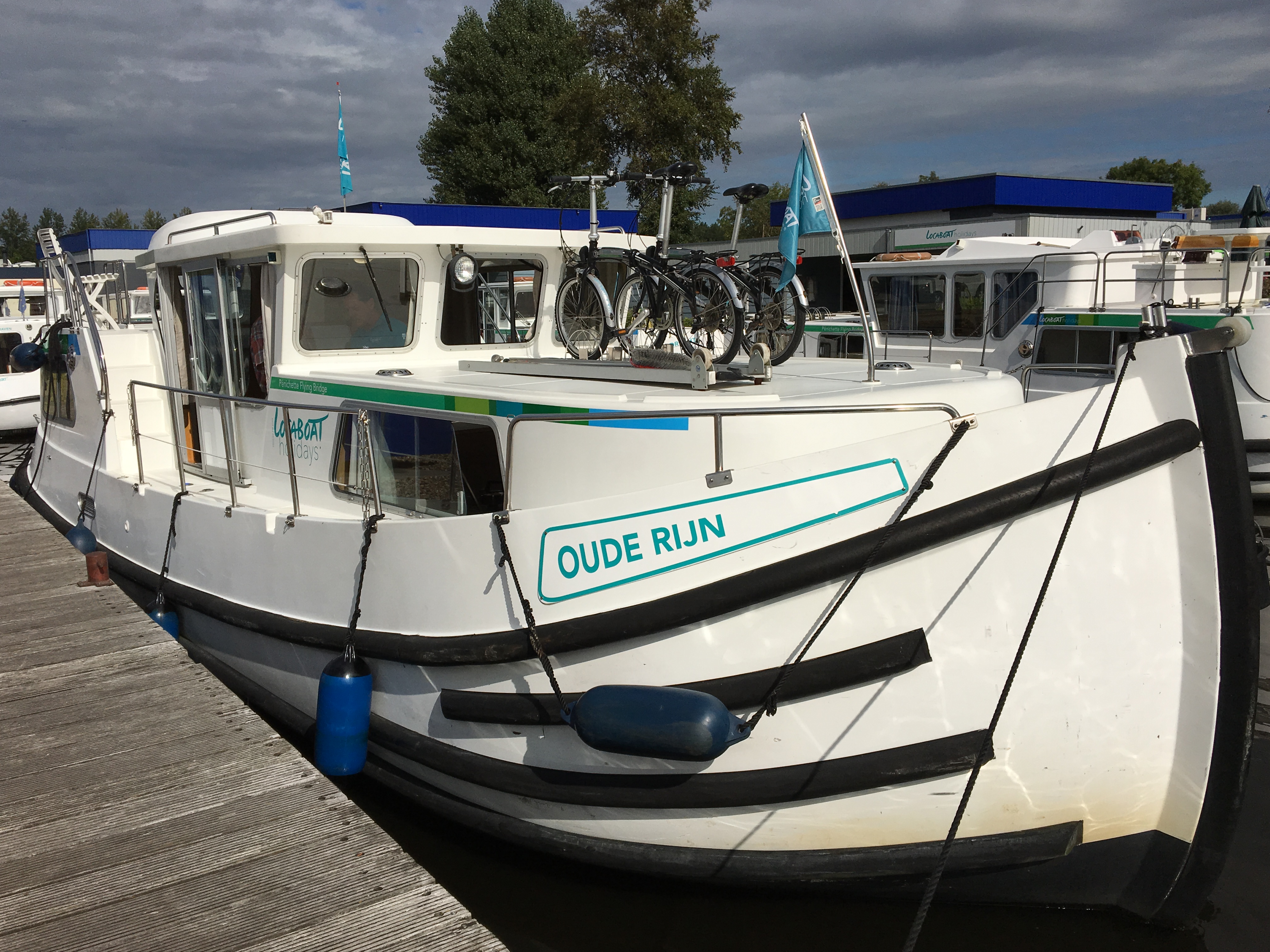 If “fietsen” (bicyling) is a Dutch favorite, “bootjevaren” (boating), which includes “zeilen” (sailing), is certainly another.
If “fietsen” (bicyling) is a Dutch favorite, “bootjevaren” (boating), which includes “zeilen” (sailing), is certainly another.
With about one third of the Dutch mainland BELOW sea level and another one third very close to it, it's no wonder that the Dutch have a special relationship with water.
Yes, Italy has Venice, which has romantic canals but also more frequent flooding. Venice also needs to worry about its future as it is slowly sinking into the Adriatic Sea.
On the other hand, Amsterdam with its many “grachten” (canals) is a vibrant international city that has well adapted to the challenges and opportunities of the ever present water. (See also European Travels 1 and European Travels 2)
And, the canal network in the Netherlands is nothing but astounding. It's a great way to explore the country.
For the fun of it, we'll sprinkle in a few Dutch words. Because Dutch is a Germanic language just like English and German, you may find some cognates.
Dutch Words
• het land - the country, land
• de stad - the city
• de fiets - the bicycle
• het water - the water
• de gracht - the canal (in a city)
• het kanaal - the canal (outside of a city)
• de rivier - the river
• de zee - the ocean, sea
Dutch Canals and Rivers
Traveling by boat on a canal or river lets you experience the countryside in a different way than driving through it. At 7 to 8 miles per hour, you can observe your surroundings in a leisurely way.
You'll notice the different designs of houses and various building methods, admire beautiful gardens, wonder what crops are growing in the fields, what type of cattle is grazing on the pastures.
Often the canals are higher than the adjacent pastures, as water is pumped continually from the lower lying fields into the canals.
While most pumps in the Netherlands are now electrically operated, there are still old windmills that are doing the job. We certainly observe more and more of the modern wind turbines every time we visit.
The ABC of Dutch Canal Travel
Operating a motor boat on Dutch canals is not really difficult, although sometimes when in tight quarters, you have to keep calm and go slowly.
You don't need a license. If you haven't sailed or operated a motor boat before, don't worry. The charter company will instruct you in how to handle the boat.
Obviously, prior boating experience helps, not only for operating a boat, but also for knowing a few basic facts:
• Boats have no brakes
• Boats are affected by wind and current
• Boats have various electrical and plumbing systems
• The forward/backward gear of boats is operated with a throttle
• Larger boats respond more slowly to throttle and steering commands
• A “bow thruster” greatly helps maneuvering in tight quarters
• “Locks” connect waterways with different water level elevations
• The lower the boat, the more bridges you can pass (without their opening)
Our 2016 Charter Choice
For our previous three canal cruises in the Netherlands, we had chartered from different local charter companies. This time we selected Locaboat, a multinational charter with locations in France, Germany, Italy, Ireland, Poland, and the Netherlands.
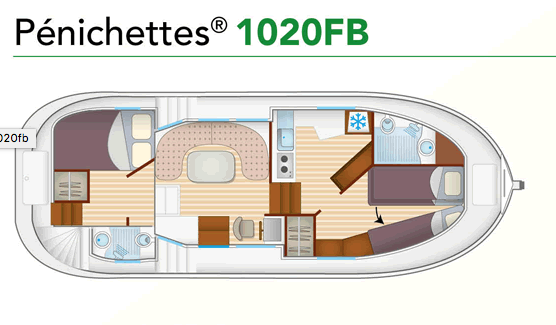 Their location in Loosdrecht, just north of Utrecht and close to the Dutch family reunion we attended, as well as our good experience with them during a charter in France a few years earlier, made them an easy choice.
Their location in Loosdrecht, just north of Utrecht and close to the Dutch family reunion we attended, as well as our good experience with them during a charter in France a few years earlier, made them an easy choice.
“Péniche” is the French word for a barge. A “Pénichette©”, Locaboat's trademarked name for its motorboats, is therefore a small barge.
We selected a “Flying Bridge Pénichette© 1020FB,” which had two cabins with toilets and showers, just right for our American friends and us.
The “Oude Rijn” (the old Rhine), as our mini barge was called, had inside and outside steering – perfect for either rainy or sunny weather – a bow thruster, and the two bicycles we had reserved.
With its 10.20 meter length (about 34 feet), it suited us fine. The midship saloon and steering station provided a great view during any meal. The compact kitchen (galley) had a refrigerator, a two-burner stove and oven, and all the pots, pans, and dishes we needed.
I noticed several improvements since the last time we had chartered from Locaboat:
• The bow thruster
• Electric instead of pump toilets
• No switch to change from inside to outside throttle operation
• A spacious refrigerator working well either on motor or shore power
• An easily operated diesel heater for the hydronic heating system
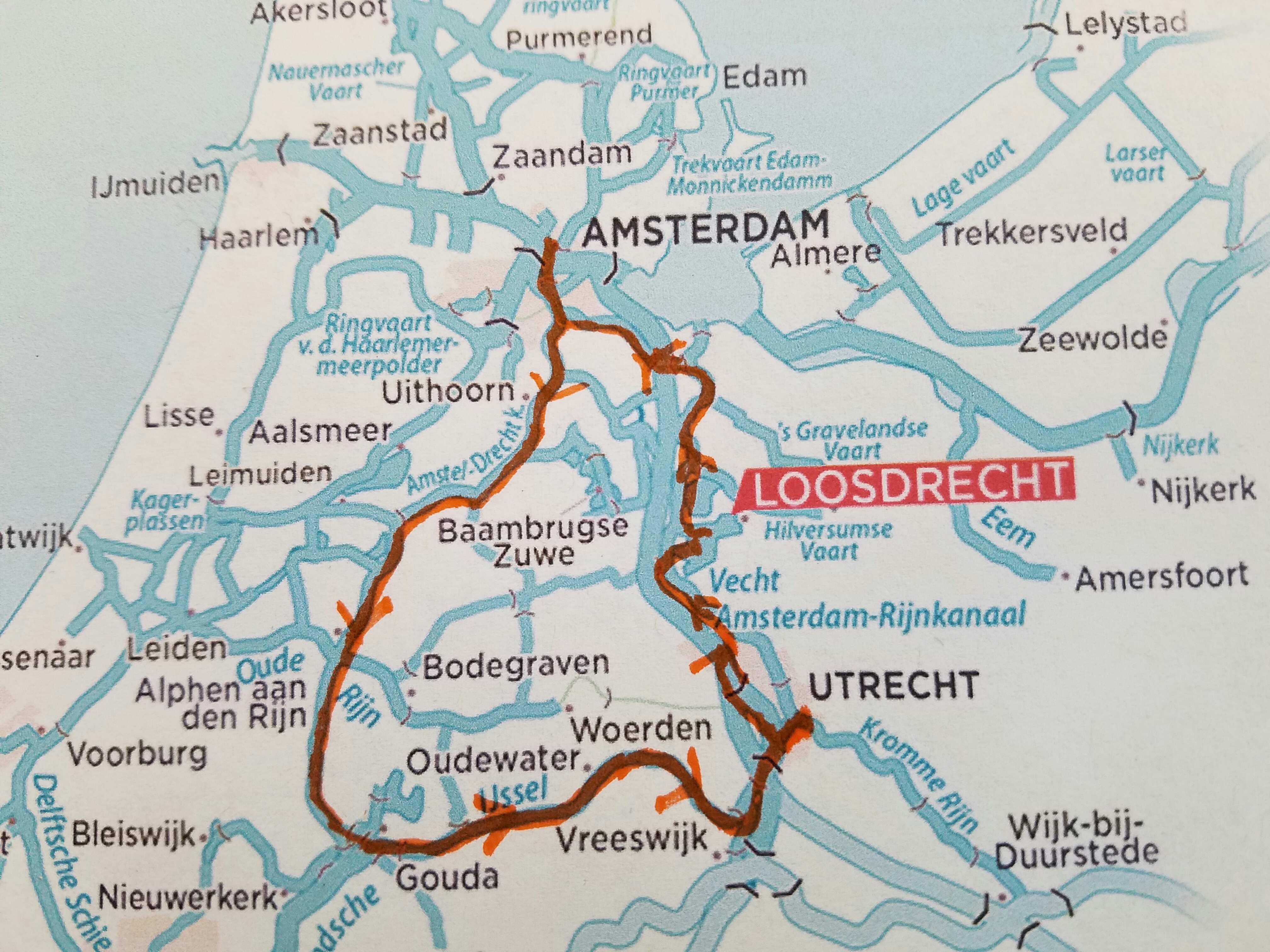 Through the charter company we had ordered some basic supplies from the local grocery store, such as water, beer, etc. These arrived shortly after we boarded.
Through the charter company we had ordered some basic supplies from the local grocery store, such as water, beer, etc. These arrived shortly after we boarded.
After reviewing our intended itinerary, (see map) learning about the boat's systems, and a quick test-outing into the canal with me backing into the slip, we started our trip.
While Locaboat reportedly makes WIFI available on its boats in France, we had to arrange for internet access ourselves in the Netherlands.
After some research I had selected my-webspot.com. The Paris, France based company had shipped the portable WIFI to our hotel. After an easy set up on the boat - it just plugged into the 12-V charger - we were connected. As we also had guests, with phones and iPads, the ability to connect up to 10 devices worked great for all of us.
It was late afternoon and we had to pass one lock and bridge before starting our round trip as shown on the chart.
Dutch Words
• de winkel - the shop
• de boot - the boat
• de sluis - the lock (on a waterway)
• de brug - the bridge
• het dorp - the village, town
• het huis - the house
• de tuin - the garden, yard
• de boerderij - the farm
Locks
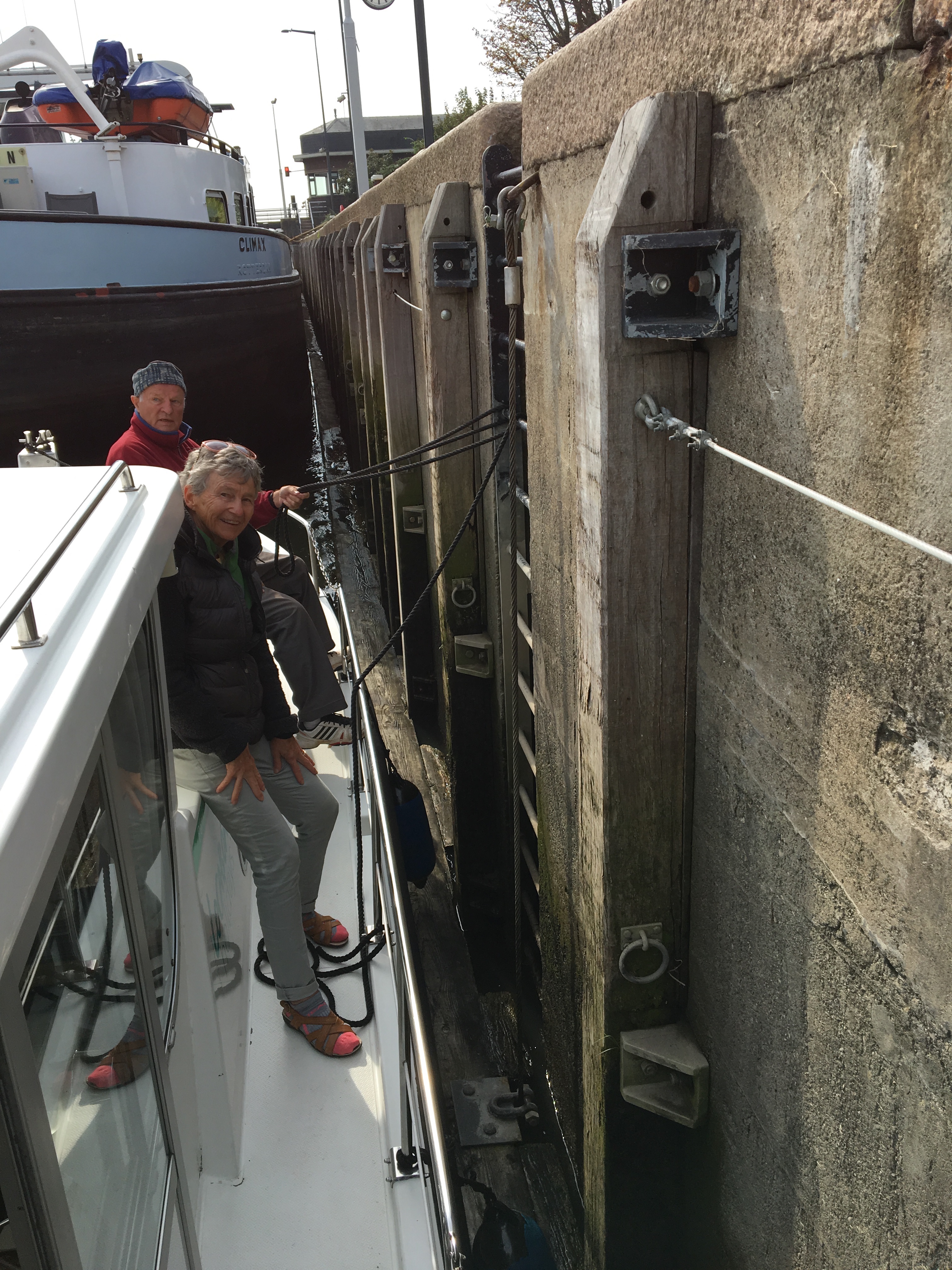 Shortly after leaving the Marina, we encountered the Mijnden Sluis, the first of the few locks that we had to pass on our trip.
Shortly after leaving the Marina, we encountered the Mijnden Sluis, the first of the few locks that we had to pass on our trip.
When approaching a lock, you'll know from the position of the gates (open or closed) and the red or green lights - whether you have to wait (red) and possibly tie up, or whether you can enter (green).
Once in the lock, your crew loops a couple of lines around the bollards and holds on to them. But they should NOT TIE UP.
As the lock gates are closed and the water level rises and falls, the crew adjusts the lines so the boat glides along the lock walls, protected by its fenders. (In this picture our friends are adjusting the lines in the biggest lock we encountered, behind a large commercial barge.)
As the lock gates open again, you motor out the other side to a different water level. In the Dutch inland canals, such level differences are often only a foot or two.
(In French canals, we had encountered a level difference of 10 feet or more in many locks. Also, in an earlier blog post, we describe how the boat lift in Henrichenburg, Germany, overcomes a 42 feet level difference.)
Bridges
We had chartered a motor boat for the first time in the Netherlands, over 20 years ago in Utrecht. Our teenage sons loved it right away. At that time, a few of the bridges still had to be opened manually. The boys had to jump ashore, open the bridge, let us pass, close the bridge, and then hop on board again.
This time, we were told that we would not have to open any bridges ourselves on our trip.
The moving bridges we encountered, called “Beweegbare Bruggen,” and labeled “BB” on the chart, were operated as follows:
• By an operator at the bridge or a person who monitored it remotely via cameras
• By a push button, typically located on a piling before the bridge
• By phone call to an operator or on an automated line
Many bridges opened as we approached, adding a yellow light to the red light before it turned green. Sometimes we called. (Telephone numbers were on a sign at the bridge. In addition, nearly all bridges had a telephone number listed in the boat manual or in the chart app on my tablet.)
More instructions were provided in the boat's handbook, but Ulrike's command of Dutch was clearly helpful for the third option.
There are only very few bridges left where the operator collects a fee with a wooden shoe on a long pole. We passed only two.
In towns and cities, operating hours often consider morning and evening traffic rush hours. Commercial vessels always have priority over recreational boats and you learn to be patient.
Your chart tells you the passing height of each bridge. Our “Oude Rijn” was listed as 2.92 m. Passing under a 3.00 m bridge left only 8 cm or a little more than 3 inches – and when steering and sitting outside on top of the upper deck we certainly had to duck. (In the above picture there were only a few inches to spare...)
Mooring Sites
The waterway chart (as well as the Dutch app for my tablet which I had downloaded earlier) not only shows all the locks and bridges, but also the marinas and mooring sites that one can tie up to.
Some of the mooring sites in small towns are free. At others, you can replenish your water or hook up your shore power (for a fee). We only did this a couple of times.
However, you're not limited to the designated mooring sites. Especially in the countryside, you can just hammer in two steel spikes ashore and tie up your boat along the canal bank.
No Hurry
After passing through the Mijnden lock, we turned north and were immediately faced with our first challenge.
The bridge operator of the first moving bridge we were to pass in Loenen, informed us that the next bridge had mechanical problems and could not be opened. He thought it could be fixed in an hour or two and suggested we should just tie up.
We did and explored the little town of Loenen, with its narrow cobble stone streets and its two picturesque bridges across the river Vecht. We also found a bakery and stocked up on fresh bread and pastries.
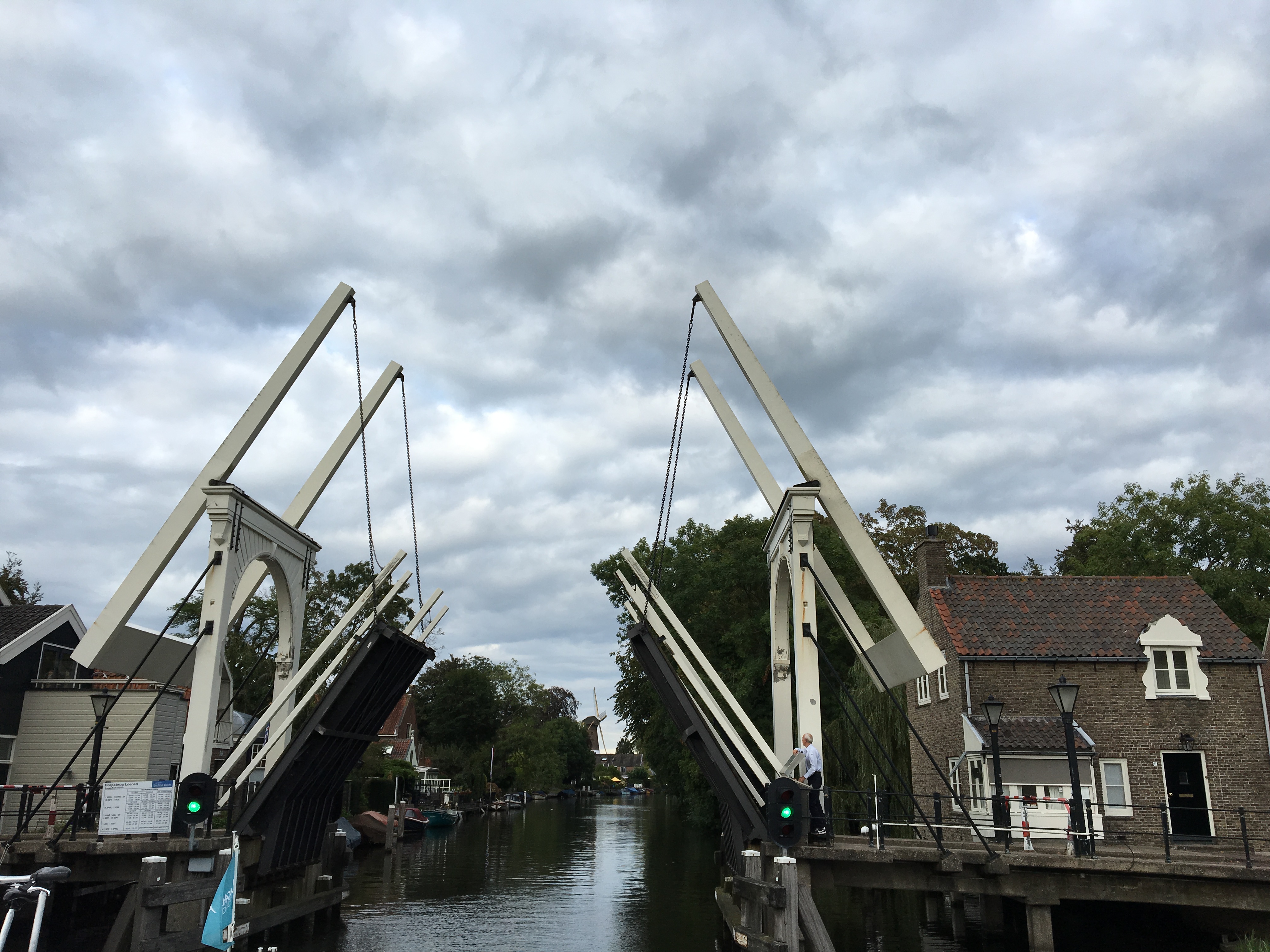 This short delay taught us again not to be in a hurry. Canal traveling has to be done leisurely.
This short delay taught us again not to be in a hurry. Canal traveling has to be done leisurely.
Yes, we would not get very far this first day, but no matter. Waiting for bridges or locks to open is as much part of canal travel as finding a nice restaurant for lunch or dinner or a good mooring spot for the night.
Indeed, when the bridge operator told us that the problem was fixed, we continued north on the Vecht. (see picture above)
As it was soon going to get dark we made fast near the small town of Overmeer.
After a 10 minute walk we found a very pleasant restaurant for our first dinner ashore. Returning a few hours later to our “Oude Rijn,” we were glad that we had not forgotten the flashlight to unlock the door.
We had a quiet and peaceful night and the next morning greeted us with sunshine and ducks and other birds in the water around us.
Sightseeing
The Netherlands is very densely populated country. In traveling along the small rivers and canals, we passed through cities and towns, as well as commercial and industrial areas. But we also came through long stretches of farm land and pastures.
In addition to the many small towns and villages we came across and explored, the major cities on our itinerary were Amsterdam, Gouda, and Utrecht.
We've written a blog post about Amsterdam, as we stayed there before getting on the boat. But visiting Amsterdam by boat is even more fun.
You can easily get to the marina in the center of town from where you'll explore the city on foot. There are a few more marinas in the outskirts, but then you have to find a way to get into the city.
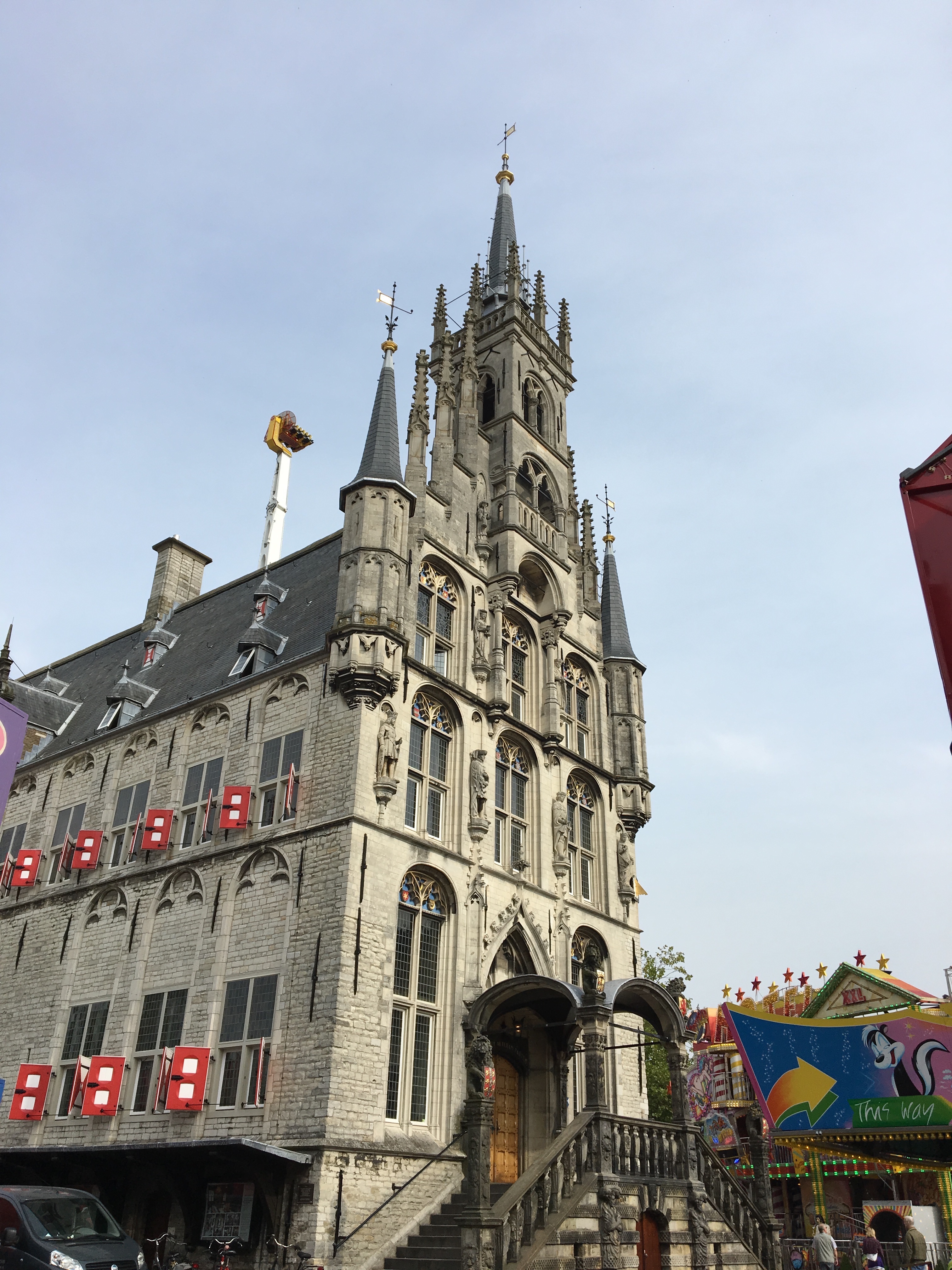 Gouda is a wonderful town with a stunning 15th-century city hall and a spacious market place, where during the spring and summer a traditional cheese market is held every week (Thursday mornings).
Gouda is a wonderful town with a stunning 15th-century city hall and a spacious market place, where during the spring and summer a traditional cheese market is held every week (Thursday mornings).
You can actually moor right in the center of town, but we chose to tie up and stay overnight on the Hollandsche IJssel, just south of the city.
When we came to Utrecht, it was not possible to go through the town with our Flying Bridge Pénichette, as the many arched bridges of the Vecht were too narrow and low for the “Oude Rijn.”
However, mooring in the “Singelgracht” close to the center of town, allows you to explore the city easily on foot.
Along the Vecht, there are many restaurants tourists and locals alike seemed to enjoy on a late summer day.
The town has over 20 museums, ranging from the Aboriginal Art, to the National Military, the Railway, and the Waterline Museum Fort Vechten.
This is often one of the major benefits of sightseeing from a boat: You can moor in or near the center of a town or city (where finding a parking space for your car may often be difficult).
Dutch words
• het stadhuis - the city hall
• het centrum - the center (of town)
• de jachthaven - the marina
• de buitenwijken - the outskirts (of town)
• de marktplaats - the market
• de kaas - the cheese
• de Noordzee - the North Sea
• de Oostzee - the Baltic Sea
The European Canal system
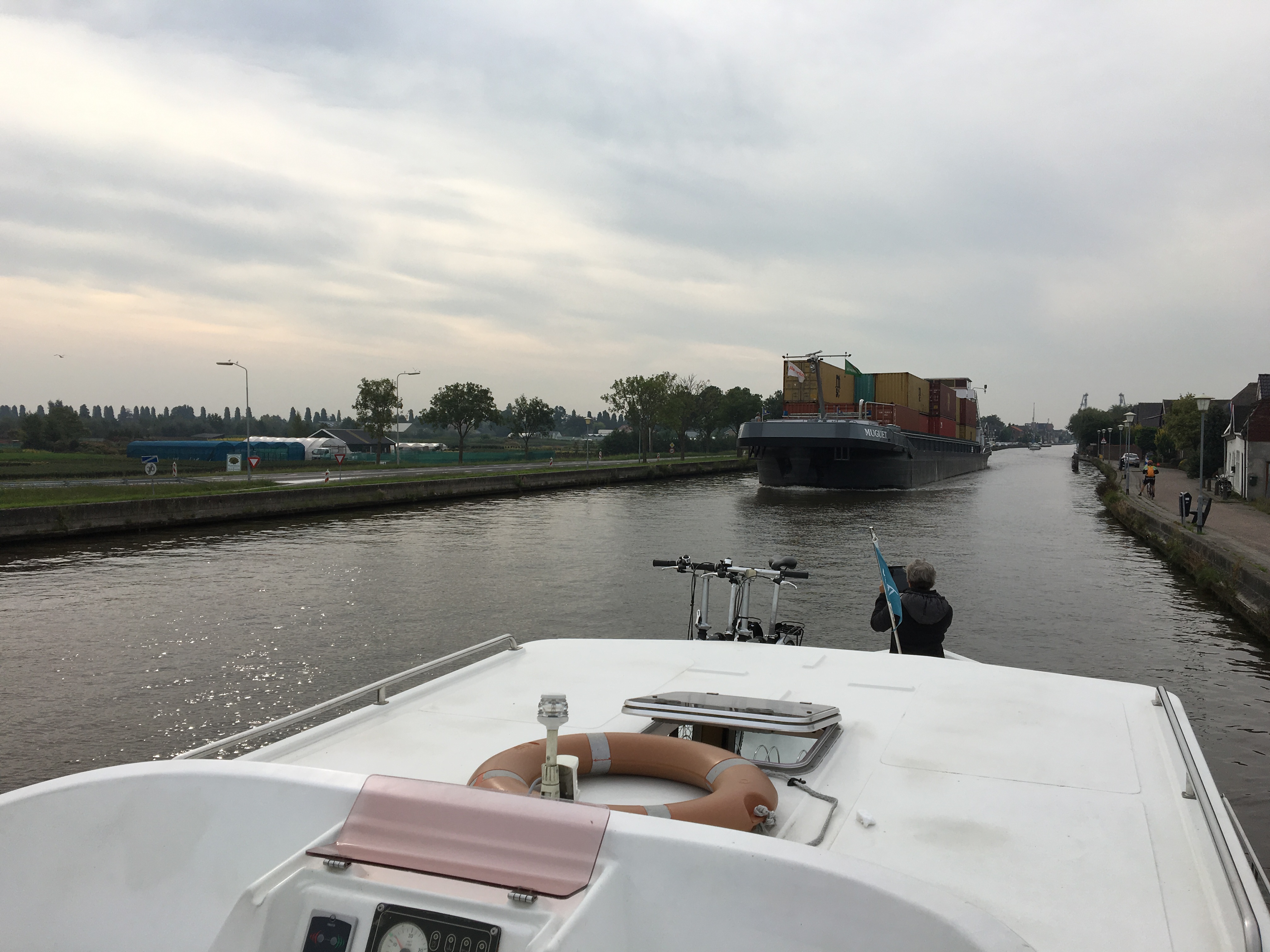 While we traveled mostly on small canals and rivers (such as the Vecht and IJssel) there were also a few stretches where we encountered commercial traffic.
While we traveled mostly on small canals and rivers (such as the Vecht and IJssel) there were also a few stretches where we encountered commercial traffic.
When a large container-laden barge is heading towards you(as on this picture), you realize how important the waterways are still for the European economy. You also do your best to keep out of the way!
Leaving Utrecht and before we could re-enter the Vecht near Maarsen, we had to travel on the wide Amsterdam-Rhine Canal. This canal serves as an important commercial link between Amsterdam and the Rhine.
Indeed, barges can make it up and down the Rhine all the way to Basel, Switzerland, or via the Main river, the Main-Danube Canal, and the Danube to Budapest, Vienna, and the Black Sea. No wonder, traffic is heavy and recreational boats like ours have to keep well out of the way.
The European canal system not only connects the North Sea with the Baltic Sea, but barges and boats (even sailboats with a lowered mast) can find their way into the Mediterranean Sea, via the Mosel and the Rhone.
Breukelen
Our last overnight stop before returning to our base was Breukelen. Breukelen, by the way, gave New York's Brooklyn its name.
We again were moored right in the center of town, behind a typical old-style bascule bridge and several restaurants. In one of them we ate dinner.
There we met the Dutch artist, Toos van Holstein, who was elected the Netherland's “Briljanten Kunstenaar 2016” (Dutch Brilliant Artist of 2016). She had just organized a special art event “25 Karaats Briljant” at the gallery Peter Leen, which is adjacent and connected to the excellent Thai Same Same restaurant.
Traveling on Dutch canals leaves you with many impressions, memories and pictures, certainly more than we can relate here.
On our last evening we could again enjoy a spectacular sunset across the huge Dutch sky - a fitting end to our canal cruise.
If you're interested in trying canal boating yourself in the Netherlands or France and have more questions, drop us a line via contact and we'll be happy to help.
You can also follow our European travels from Utrecht to Lake Constance, and Discoveries in Austria.
Bio: Ulrike & Peter Rettig are co-founders of Gamesforlanguage.com. They are lifelong language learners, growing up in several European countries before moving to Canada and the United States. You can follow them on FacebookTwitter and Instagram, and leave any comments with contact.
